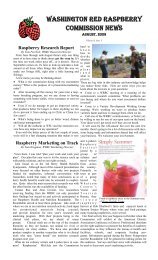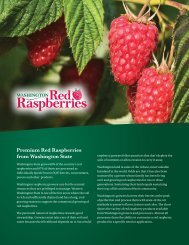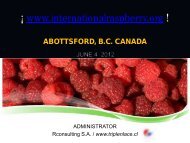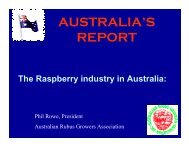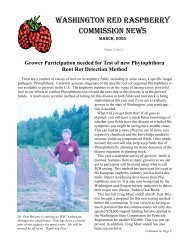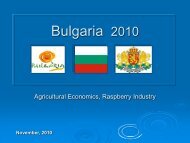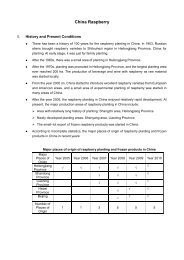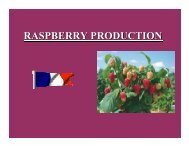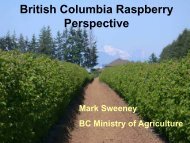2012 - Washington Red Raspberry Commission
2012 - Washington Red Raspberry Commission
2012 - Washington Red Raspberry Commission
You also want an ePaper? Increase the reach of your titles
YUMPU automatically turns print PDFs into web optimized ePapers that Google loves.
than most other varieties but are still long enough for use in a ‘looped’ trellis system. Ukee laterals are long and<br />
strong and carry the yield very well; fruit is spread on the laterals and is well presented. Ukee fruit have a nice<br />
conical shape and the fruit are medium to large with small drupelets. Fruit colour is medium to light red with low<br />
gloss and a dusty appearance. Ukee is productive and maintains good fruit size over its long harvest season. The<br />
fruit colour is lighter than that of Meeker; it is acceptable for IQF and possibly for other types of processing<br />
where dark pigment is not required. In machine harvest trials Ukee rated as suitable for machine harvesting,<br />
giving good fruit quality that is suited for IQF. In IQF trials it appears acceptable, but more testing is needed. The<br />
ripening season for Ukee is similar to that of Meeker. Because of its long laterals, Ukee fruit is exposed and<br />
therefore easy to hand harvest. The fruit size is larger than that of Meeker. Ukee was selected for resistance<br />
conferred by the Ag 1 gene to the common biotype of A. agathonica, the N. American large raspberry aphid vector<br />
of the RMV complex, and it has tested negative to RMV ever since the genotype was selected. It has exhibited a<br />
high degree of field resistance to root rot caused by P. rubi and under extreme root rot pressure at WSU Puyallup<br />
it did not show symptoms. While not resistant to spur blight, (Didymella applanata), Ukee has been rated as less<br />
susceptible than Meeker, Malahat, Chemainus or Tulameen. Ukee, Meeker, Saanich and Malahat have similar<br />
(low) susceptibility to cane Botrytis (B. cinerea) and show more resistance than Tulameen or Chemainus. Ukee is<br />
moderately susceptible to anthracnose (Elsinoe veneta), having a response similar to Meeker.<br />
Rudi (BC 86-41-15 x Qualicum): Rudi is a new floricane-fruiting red raspberry cultivar from the PARC breeding<br />
program. Rudi produces a high yield of firm, large fruit that mature early, machine harvest very well, and are<br />
suited for processing and the fresh market. It was named after Mr. Rudi Janzen on whose field this cultivar was<br />
tested. Mr. Janzen played an important part in the testing and evaluation processes of the cultivar. Rudi tested as<br />
BC 90-4-23, was selected from a 1990 cross of the PARC released cultivar, Qualicum, and selection BC 86-41-<br />
15. Qualicum was selected from a cross between the SCRI cultivar Glen Moy and Chilliwack. The other parent,<br />
BC 86-41-15, comes from a 2 nd back cross from the North American wild raspberry R. strigosus (the Dalhousie<br />
Lake 4 clone). Rudi floricanes are straight, strong, and thinner than those of Tulameen, Malahat and Chemainus<br />
but similar to those of Saanich and Meeker. When selected in 1994 from a single plant, it was noted as being early<br />
ripening with long laterals, attractive appearance, nice flavor, firm fruit just over 4 g, only a few spines, and easy<br />
to harvest. Rudi laterals are long and strong and carry the yield very well; fruit is spread on the laterals and is well<br />
presented. Rudi fruit have an excellent appearance; fruit are medium to large in size and conical with medium size<br />
drupelets. Fruit colour is medium to dark red with high gloss. Rudi is productive and maintains a good fruit size<br />
over its harvesting season. The fruit colour is similar to that of Meeker; it is acceptable for processing where dark<br />
pigment is required. It machine harvests very well with harvest starting a few days before Meeker and ending<br />
almost a week before Meeker. While not resistant to spur blight (Didymella applanata), Rudi has been rated as<br />
less susceptible than Meeker, Malahat, Chemainus or Tulameen. Rudi, Ukee, Meeker, Saanich and Malahat have<br />
similar (low) susceptibility to cane Botrytis (B. cinerea) and show more resistance than Tulameen or Chemainus.<br />
Rudi is moderately susceptible to anthracnose (Elsinoe veneta), having a response similar to Meeker. Rudi is a<br />
multi-purpose cultivar that is suited for machine harvesting/processing and the fresh market.<br />
BC 90-8-11 (BC 86-41-24 x Qualicum): This is a 3 rd backcross from a R. strigosus Dalhousie Lake 4 clone. It<br />
produces large mid-to-late season crop that is suited for the fresh and processing markets. The fruit is large (5.5 g)<br />
and meaty, light red in color, glossy, firm, conical in shape and very attractive. The plant has a good vigor with<br />
light green foliage an upright habit and producing enough replacement canes. The fruit is well spaced and<br />
presented on the laterals. It is susceptible to RBDV and moderately susceptible to cane diseases. It is resistant to<br />
aphids.<br />
BC 90-8-20 (BC 86-41-24 x Qualicum): A productive mid-season selection that produces very large long meaty<br />
fruit (5.9 g) that is a dull light red in color and most suitable for the fresh market. This selection is not suited for<br />
mechanical harvesting. The large, low-gloss fruit strongly resembles Qualicum. Plant vigor is not excessive with<br />
leaves that are large and light green color, laterals are long. It does not appear to be field resistant to root rot. It is<br />
susceptible to RBDV and moderately susceptible to cane diseases.<br />
BC 90-11-44 (Algonquin x Qualicum): This is a very productive selection that produces over an extended harvest<br />
season. The attractive fruit is large, glossy, and firm, with very fine drupelets and producing a high early to mid<br />
022



